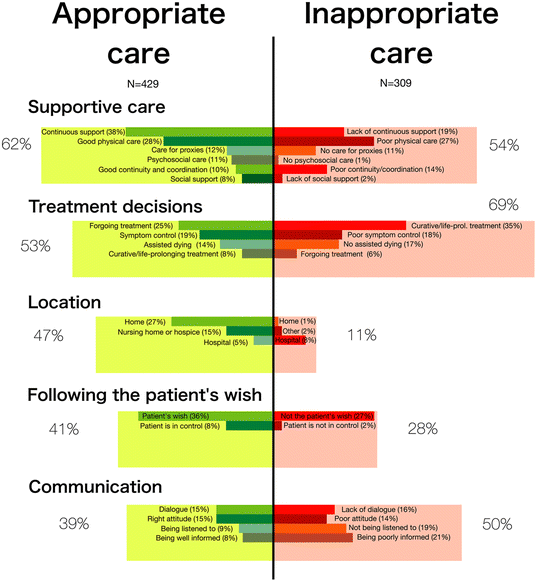Appropriate and inappropriate care in the last phase of life: an explorative study among patients and relatives
- PMID: 27846832
- PMCID: PMC5111254
- DOI: 10.1186/s12913-016-1879-3
Appropriate and inappropriate care in the last phase of life: an explorative study among patients and relatives
Abstract
Background: Many people are in need of care in the last phase of life. However, the care they receive is not always appropriate. For instance, people can receive overly aggressive treatment or can have limited access to palliative care. The term appropriate care is often used by policy makers, while it is unclear what care recipients consider as appropriate care. This study aims to identify what care patients and relatives perceive as appropriate and as inappropriate in the last phase of life, for patients suffering from different conditions.
Methods: We designed an online survey with open questions. Participants were recruited through organizations for patients, older people and medical professionals. Answers were analysed after data-driven coding. Forty-five patients and 547 relatives described the care they received and described why this care was appropriate or inappropriate.
Results: Participants described more cases of appropriate care than inappropriate care. The cases of appropriate care were diverse, but all involved care in (one or more of) five dimensions; supportive care, treatment decisions, location, the role of the patient's wish and communication. Each of these dimensions was frequently described (39-62 %). When care was inappropriate, this mostly involved inappropriate treatment decisions (69 %; especially overtreatment was frequently mentioned), and poor communication (50 %). There was considerable consistency in what was seen as (in)appropriate care across different conditions. However, especially patients suffering from other physical diseases than cancer more often received inappropriate care.
Conclusion: From the perspective of patients and relatives, appropriate care in the last phase of life is a broad concept. Caregivers should be aware of the diversity of care needs in the last phase of life. Especially treatment decisions and communication can be improved.
Keywords: Appropriate care; End-of-life care; Palliative care; Patient perspective; Quality of care.
Figures

References
-
- Ferrell BR. Overview of the domains of variables relevant to end-of-life care. J Palliat Med. 2005;8(Suppl 1):S22–S29. - PubMed
MeSH terms
LinkOut - more resources
Full Text Sources
Other Literature Sources

